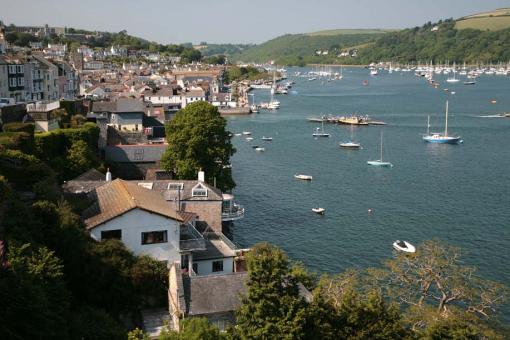 River Dart and Dartmouth
River Dart and Dartmouth
Dartmouth is built in the valley of the picturesque River Dart, between steep wooded hillsides. The main South Embankment runs the length of the town, from New Ground, built on land reclaimed from the river, towards the historic Bayard’s Cove. This long stretch along the riverside provides visitors with a pleasant and relaxing promenade from which they can admire the sights of the busy estuary. There are many pleasure boat trips departing from the quay. Dartmouth is well geared up for tourism, offering the visitor an array of cafés, restaurants, boutiques and specialist shops.
The main artery of Dartmouth was always the river rather than the road. In fact there has never been a main road down into the town. This has helped to retain the historic atmosphere of the narrow streets and old buildings. Dartmouth’s oldest building, the Cherub Pub, was built around 1380 in Higher Street. Agincourt House at Lower Ferry is another example of the few 14th century buildings surviving in the town.
The Butterwalk, with its timber framed arcade was built in between 1635 and 1640. Its impressive façade was damaged by bombs during the Second World War but it has now been fully restored. It houses the town’s museum. Dartmouth’s narrow streets, with their long flights of winding steps, boast many intriguing medieval buildings.
Thomas Newcomen was born in Dartmouth in 1663 and is known as the inventor of the Steam Pumping Engine, the first industrial steam engine which was adapted by Watt about fifty years later. A working 19th century example of one of Newcomen’s engines can be seen in the Engine House close to the Butterwalk.
For almost a thousand years, sailors have sailed all over the world from this ancient harbour. The Normans used Dartmouth to trade with their homeland across the English Channel. Both the Second and Third Crusades assembled and departed from Dartmouth’s old riverside quays.
Cobbled Bayards Cove has changed little since the quay was built in 1539. The Cove featured in the television series The Onedin Line. At the southern end of Bayard's Cove is a small artillery fort built by Dartmouth Corporation in 1510 to provide additional protection for the harbour. The Pilgrim Fathers put into the Cove, on their way from Southampton to the America. They stayed for a time before setting off on their epic journey in the Mayflower and the Speedwell on the 20 August 1620.
Two castles have guarded the mouth of the River Dart for centuries. Dartmouth Castle was built in 1481 and featured many innovative defences being the first castle in the country constructed specifically for artillery. In times of war a heavy chain was strung between this building and Kingswear Castle, on the opposite bank of the river, affording this deep water anchorage even greater protection. This ensured the safety both of ships at anchor and the homes and warehouses of Dartmouth’s merchant community.
Perhaps Dartmouth today is best known for the Royal Naval College. The college was built in 1905 and is officially called Britannia. This was the name of one of the wooden hulks that previously housed the trainee officers on the River Dart. It was in fact the first of the hulks to be superseded by the college. Today the name of Dartmouth is synonymous with naval tradition.



